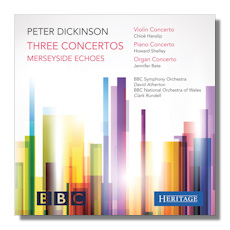
The Internet's Premier Classical Music Source
Related Links
- Dickinson Reviews
- Latest Reviews
- More Reviews
-
By Composer
-
Collections
DVD & Blu-ray
Books
Concert Reviews
Articles/Interviews
Software
Audio
Search Amazon
Recommended Links
Site News
 CD Review
CD Review
Peter Dickinson

- Violin Concerto (1986) *
- Piano Concerto (1979-1984)
- Organ Concerto (1971)
- Merseyside Echoes (1986) *
Chloë Hanslip, violin
Howard Shelley, piano
Jennifer Bate, organ
BBC Symphony Orchestra/David Atherton
* BBC National Orchestra of Wales/Clark Rundell
Heritage HTGCD276
None of these works is recent, and only the starred works were recorded recently, on 2 and 3 April 2014. The recordings of the Piano and Organ concertos are the same as the ones I reviewed in 2010 (Albany 360).
It is good to have the three concertos on a single disc.
With only a couple of minor exceptions, I have long admired Peter Dickinson's compositions – and books, for that matter – and have reviewed many of them. With no compelling reason to repeat or qualify what I said about the Organ Concerto and Piano Concerto five years ago, I shall focus here on his Violin Concerto and Merseyside Echoes.
By way of further preface, let me recommend a substantial retrospective article about Dickinson by Richard Leigh Harris, in honor of Dickinson's eightieth birthday, published in the excellent quarterly British publication Musical Opinion, October-December 2014, issue no.1501. (Let me say also that this publication is well worth the price for North American readers, as it has substantial articles and is virtually advertisement free).
Like his other concertos, which Dickinson in his notes says "form the core of [his] output," the Violin Concerto is in a single movement with many distinct sections: twelve in this case, marked Allegro, L'istesso tempo [same tempo regardless of meter changes], Waltz, Variation II and III, Adagio, Lamentoso, Tranquillo, Grave, Ritmico [rhythmic], Pesante [emphatically weighty], Meno mosso [less agitated]. In the spirit of Ives and Cage, Dickinson has embraced contrast in musical styles, calling this eclectic approach "style modulation." He once delivered a lecture explaining that term. Not only is there stylistic variety within the work; there is also tremendous dynamic range, from very hushed to very loud. There is a lot of percussion, both loud and soft. All this is very expressive; there is no danger of listeners nodding off. This may not be to every taste, but I find it exciting and satisfying overall, and I would not say that of certain other eclectic works I shall not mention.
The Violin Concerto opens with a loud crash, followed by a trumpet tune, accompanied by an extended ostinato of soft drum patter. After a minute and a half the solo violin enters, sweetly. A flute and xylophone are also noticeable. What we hear at this point is a quiet but complex whispering from the orchestra, until the end of Variation III, which is one of the very loud parts. The Adagio follows, very hushed, and the Lamentoso is what you might expect, with tolling of bells and drum taps; a crescendo is marked by lots of percussion. All sections up to this are very brief; the following – hushed – Tranquillo is the longest section at four and one half minutes; here the violin is more prominent and the percussion is tinkly. In the short Grave section the violin plays forcefully for the first time and it has a quasi-cadenza, with light accompaniment. Loud brass follows, before the bouncy Ritmico, which represents the most pronounced change of style. The pounding Pesante leads to the calmer finale, with pounding dynamics only at the very end. This is a most unusual, and interesting, violin concerto.
In his notes to the Violin Concerto, Dickinson says "the main theme of the first movement is from Beethoven's Spring Sonata", but "turned into a waltz as well as a kind of 1930s popular song." The opening "trumpet declamations" are based on a "motto theme using the musical letters in the name of Ralph Holmes" with whom he played the Beethoven: A-B-E-Eb. "These generate echoes…"
Merseyside Echoes is short – less than nine minutes – Dickinson describes as a "tribute to the sound of the early Beatles, dedicated to [his]son Jasper." Opening with a fanfare, it has a bass melody from Dickinson's setting in his E. E.Cummings Song Cycle. Two pop songs "close to the style of the early Beatles" are given to the cor anglais and the vibraphone. The fanfare returns twice.
All this music is fresh and inventive. I recommend it.
Copyright © 2015 by R. James Tobin.




















